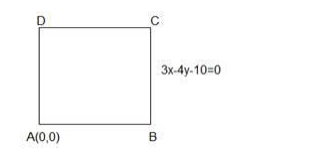A vertex of a square is at the origin and its one side lies along the line 3x – 4y – 10 = 0.
Find the area of the square.
Given: $A B C D$ is a square and equation of $B C$ is $3 x-4 y-10=0$
To find : Area of the square

Formula used:
We know that the length of perpendicular from $(m, n)$ to the line $a x+b y+c=0$ is given by,
$D=\frac{|a m+b n+c|}{\sqrt{a^{2}+b^{2}}}$
The given equation of the line is $3 x-4 y-10=0$
Here $m=0$ and $n=0, a=3, b=-4, c=-10$
The given equation of the line is $3 x-4 y-10=0$
Here $m=0$ and $n=0, a=3, b=-4, c=-10$
$D=\frac{|3(0)-4(0)-10|}{\sqrt{3^{2}+4^{2}}}$
$D=\frac{|0+0-10|}{\sqrt{9+16}}=\frac{|-10|}{\sqrt{25}}=\frac{|-10|}{5}=\frac{10}{5}=2$
D = 2
Side of the square $=D=2$
Area of the square $=2 \times 2=4$ square units
Area of the square $=4$ square units
Click here to get exam-ready with eSaral
For making your preparation journey smoother of JEE, NEET and Class 8 to 10, grab our app now.
